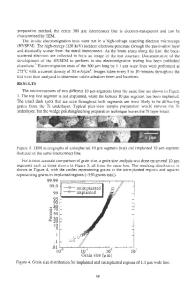Electromigration Resistance of Multilayer Aluminum/Titanium Interconnects
- PDF / 289,150 Bytes
- 6 Pages / 420.48 x 639 pts Page_size
- 89 Downloads / 501 Views
H. RONKAINEN,
M. BLOMBERG,
and I.
SUNI
Semiconductor Laboratory, Technical Research Centre of Finland Otakaari 7 B, SF-02150 Espoo, Finland ABSTRACT We have investigated the electromigration resistance of Al-Si/Ti multilayer interconnects. For comparison Al-Si and Al-Si/Ti/Al-Si films were also prepared. The linewidths ranged between 1.6 and 5 4 um. A temperature-ramp resistance analysis was applied at direct wafer le l, to detect electrikinetic cally transport of material and derive the electromigration parameters in test vehicles with different geometries. 1.
INTRODUCTION
Electromigration resistance of Al or Al-Cu interconnections can be significantly improved by incorporating a compound of Al and a transition metal inside the metallization layer [1,2]. Improvements in the lifetime by at least one order of magnitude have been reported. It has also been shown that replacing the homogeneous metal layer with a multilayer structure the formation of hillocks for heat treatments up to 30 min at prevents 450 0C [3]. In this paper we present results of a study on electromigration resistance in interconnects with linewidths ranging between 1.6 and 5 ,um, prepared by incorporating single or multiple layers of Ti in Al-Si films. In particular, in this work, a temperature-ramp resistance analysis, [4] , has been
applied at direct wafer level to detect electrically the transport of material, and to determine the electromigration kinetic parameters in test
vehicles with different geometries. 2.
EXPERIMENTAL
The metal films were deposited on oxidized silicon substrates (SiO thickness = 1500 A). Three different types of metallizations were p~epared, using magnetron sputtering (see fig. 1). In the first structure of Al-I%Si/Ti/Al-1%Si the layers, of approximately 2200, 600 and 2200 A respectively, were deposited during the same pumpdown. The second structure consisted of four Al-Si layers, 1100 A thick each, alternating with three 200 A thick Ti films. For a direct comparison of the electromigration behaviour in unlaminated structures, Al-Si films of 5.000 A thickness were also prepared. After sputtering, three different types of electromigration test vehicles, shown in fig.2, were delineated by standard photolithography and chemical wet etching. The structures were then annealed in an argon gas flow. Fig.3 shows the behaviour of the sheet resistance as a function of the annealing time, for thermal treatments at 4000 and 450'C. The increase of the sheet resistance in the layered structures is attributed to the consumption of Al to form the intermetallic AlTi. In this electromigration study we present results obtained on stripe• which were preannealed at 450'C for 30'. * Permanent address: Bologna, Italy
CNR/Istituto LAMEL,
Mat. Res. Soc. Symp. Proc. Vol. 54.
Via d6 Castagnoli,
1986 Materials Research Society
1 - 40126
812
AAe-1%Si (a)
A Ae-i%Si
-2200
-
600 AT
-2200A
(b)
Ae-l%si
(a) i • 2ooA T, -• 1100A AP-1% S. -
200 T.c
-
200 00
8T,
St02
Fig. F1
Metallization schemes (b)
Fig. 2 Test vehicles
-
Data Loading...











